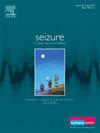Characterization of a unique patient cohort with spike-wave activation in sleep without cognitive decline or increased seizure burden: Considerations for a more conservative treatment approach
IF 2.7
3区 医学
Q2 CLINICAL NEUROLOGY
引用次数: 0
Abstract
Objective
The goal of this study is to better characterize a unique subset of patients who present with so-called “isolated SWAS” (Spike Wave Activation in Sleep) by analyzing electrographic and neuropsychological data.
Methods
We evaluated our institution's population of patients with SWAS, defined as >/= 50 % spike-wave index potentiated during slow-wave sleep. Of this group, 26 patients were identified with no worsening cognitive performance or seizure burden at the time of diagnosis, deemed “isolated SWAS”, in comparison to patients with Developmental and/or Epileptic Encephalopathy (D/EE)-SWAS. Paraclinical studies of this cohort were analyzed, including high-frequency oscillations, specifically on scalp electroencephalogram as well as comprehensive behavioral and neuropsychologic data at one-year follow-up.
Results
We found that 80 % (n=21) of the cohort was started on a unique treatment for SWAS at the time of diagnosis, with the most common treatment being clobazam (n=12; 57 %) followed by valproic acid (n=9; 43 %). The cognitive performance of patients who received treatment and those who did not receive treatment was not statistically significant, and after one year of follow-up the patients who did not receive treatment for SWAS had no cognitive decline. Furthermore, the treatment group reported more medication side effects (n=14/21; 67 %). Seven patients (27 %) of the cohort continued to have SWAS at follow-up, and 11 patients (42 %) had ongoing seizures. The presence of ripples did not correlate with cognitive outcomes.
Significance
This study suggests that if patients have “isolated-SWAS” at the time of diagnosis a more conservation approach may be considered.
睡眠中无认知能力下降或癫痫发作负担增加的尖峰波激活的独特患者队列的特征:考虑采用更保守的治疗方法
目的:本研究的目的是通过分析电图和神经心理学数据,更好地描述所谓的“孤立性睡眠中尖峰波激活”(SWAS)患者的独特亚群。方法我们对本院的SWAS患者进行评估,定义为>;/= 50%的慢波睡眠时峰波指数增强。与发育性和/或癫痫性脑病(D/EE)-SWAS患者相比,该组26例患者在诊断时没有认知能力恶化或癫痫发作负担,被认为是“孤立性SWAS”。对该队列的临床旁研究进行分析,包括高频振荡,特别是头皮脑电图,以及一年随访期间的综合行为和神经心理学数据。结果我们发现,80% (n=21)的队列患者在诊断时开始接受SWAS的独特治疗,最常见的治疗是氯巴唑(n=12;57%),其次是丙戊酸(n=9;43%)。接受治疗与未接受治疗的患者认知能力差异无统计学意义,随访1年后未接受SWAS治疗的患者认知能力无下降。此外,治疗组报告了更多的药物副作用(n=14/21;67%)。随访时,7名患者(27%)仍有SWAS, 11名患者(42%)持续发作。涟漪的存在与认知结果无关。意义本研究提示,如果患者在诊断时有“孤立性swas”,可以考虑采用更保守的方法。
本文章由计算机程序翻译,如有差异,请以英文原文为准。
求助全文
约1分钟内获得全文
求助全文
来源期刊

Seizure-European Journal of Epilepsy
医学-临床神经学
CiteScore
5.60
自引率
6.70%
发文量
231
审稿时长
34 days
期刊介绍:
Seizure - European Journal of Epilepsy is an international journal owned by Epilepsy Action (the largest member led epilepsy organisation in the UK). It provides a forum for papers on all topics related to epilepsy and seizure disorders.
 求助内容:
求助内容: 应助结果提醒方式:
应助结果提醒方式:


